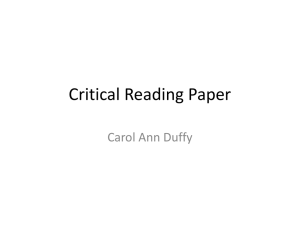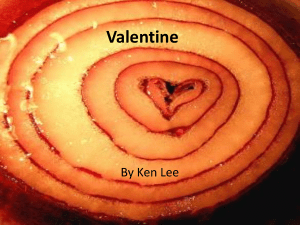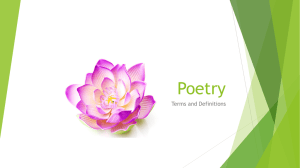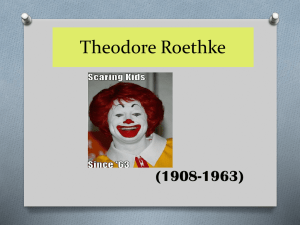Valentine - Deans Community High School
advertisement
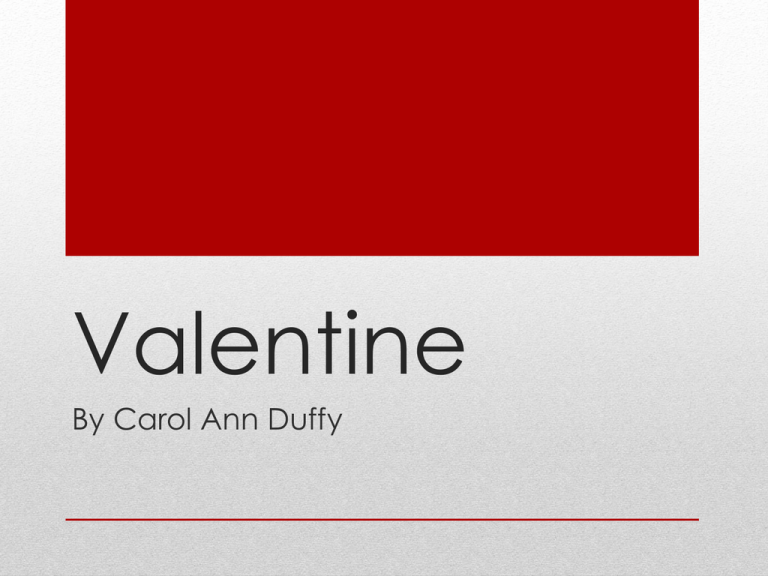
Valentine By Carol Ann Duffy • Duffy’s style is contemporary and she is renowned for giving voice to those who have been alienated or edited in history. • Duffy also writes from a personal perspective about complex situations, but her use of language makes these works highly accessible and intriguing. Style • ‘Valentine’ – explores the different stages of a modern relationship through the extended metaphor of an onion. • ‘Havisham’ – re-examination of Dickens’ character Miss Havisham and her bitter heartbreak, as evoked through brutal imagery. • ‘War Photographer’ – the damaging observations of conflict, its victims and its distant observers, told through the eyes of the photographer who captures the brutal images. • ‘Anne Hathaway’ – a sonnet that gives voice to Shakespeare’s ‘neglected’ wife. Here she tells her romanticised version of their relationship. • ‘Mrs Midas’ – examines the consequences of selfish and vain decisions in modern relationships, written using the myth of Midas and from the perspective of his fictional wife. • ‘Originally’ – Duffy’s personal poem about her experiences with dual identity. Her physical transition from Scotland to England is explored, as is the transformation from child into adult. Themes and Links of set poems Not a red rose or a satin heart. I give you an onion. It is a moon wrapped in brown paper. It promises light like the careful undressing of love. Here. It will blind you with tears like a lover. It will make your reflection a wobbling photo of grief. I am trying to be truthful. Valentine Not a cute card or a kissogram. I give you an onion. Its fierce kiss will stay on your lips, possessive and faithful as we are, for as long as we are. Take it. Its platinum loops shrink to a wedding-ring, if you like. Lethal. Its scent will cling to your fingers, cling to your knife. • Havisham • • • • • • • Love (rejected) Senses/sensory images Repetition Symbolism Colour Metaphor Narrative voice • Valentine • • • • • • • Love (offered) Senses/sensory images Repetition Symbolism Colour Metaphor Narrative voice Compare and contrast. In your groups prepare a presentation on your stanza. Examine: 1. Mood, imagery, 2. metaphor, themes, 3. Narrative voice and tone 4. Structure and word choice. 5. Symbolism and literary devices -------------------------------------------------------Enjambment, caesura, colour symbolism, alliteration, plosives, sibilance, metaphor, simile, oxymoron, dark imagery, voice, climax, Analyse word choice and aspects of punctuation. You should also refer to how mood is created, How Duffy uses narrative voice, tone and symbolism Valentine Collaborative Learning • Stages of a modern relationship • Extended metaphor of the onion • Is actually a true representation of Duffy’s relationship • This suggests Duffy is criticising/rejecting conventional ideas and empty gestures of love. • She is promising her lover, and the reader that her love is more original, honest and true. • The extended metaphor of the onion being like her love runs through the whole poem. • By doing this Duffy turns an ordinary object, an 'onion' into an unusual symbol of love, and makes it seem a more appropriate symbol than traditional Valentine gifts. Symbols, themes and metaphor • Mood is optimistic, romantic in an unconventional way. It appears personal through first person narrative. I give you… • Onion metaphor looks at aspects of love and relationships, • Image of conventional love gifts start the poem • Not a red rose, satin heart… this is then subverted by I give you an onion. Like Havisham the opening lines are very striking and through unconventional language we are pulled into the world of the poem. The Onion and Beloved sweetheart bastard intrigue and shock the reader from the outset by the tone and ambiguity of the narrative voice. • The mood is calm, the narrator self-assured as she reveals how the onion represents stages of a love affair or relationship. She makes commands, requests and explains why the metaphorical onion is important. Take it, here, I give you are all actions from the narrator to show her commitment to the symbolic layers of an onion. • Imagery is used at the end of the poem of wedding rings, perhaps echoing the reasons for Havisham’s desolation, as she was denied this matrimonial symbol. The narrator says ‘if you like’ to make a request of her lover and link the layers and rings of the onion to their relationship. Group 1 2014 Mood and Imagery • The title Valentine omits the word ‘Saint’ in connection with the day that is celebrated by lovers, which leads to ambiguity; similar to the poem Havisham. This removes the idea of traditional love and romance and subverts it with new symbols. Havisham removes the title ‘Miss’ present in the character in Great Expectations to show that this woman is a ‘Spinster’ and therefore perceives herself as alone and unloved. • The theme of love is established from the start. • The unwrapping of the ‘brown paper’ from the ‘moon’ suggests emotional and physical exposure that comes with love. • There seems to de a desperation to give love and have it accepted in the poem that is always tinged with insecurity. ‘Possessive and faithful as we are/ for as long as we are; suggests that all love is fragile and will one day end. • The onion is the main extended metaphor and it represents different stages in a relationship. ‘Light’ and the passion of love are suggested, ‘tears’ show the fragility and sometimes sadness in love, ‘possessive and faithful’ shows the expected loyalty, contrasting deeply with the word choices in Havisham, and the ‘scent’ of the onion represents the memories and residual emotional feelings leftover when a love affair breaks down. Group 2 2014 metaphor and themes • Sensory images start the poem. ‘Not a red rose or a satin heart / I give you an onion’. The vivid symbolic red colour of the traditional Valentine gift: the rose is negated, by the word ‘Not’, and replaced with the plain onion wrapped in ‘brown paper’. We associate smell and taste with this new symbol of love and Duffy plays on the reader’s ability to imagine the sights, smells tastes and experiences involved in this extended metaphor. She moves the reader away from the traditional notions of love into an unconventional view on love. • The onion is compared to the moon, which is a symbol of love and ironically, in this context, madness. The onion when cut reveals ‘platinum loops’ or wedding rings. • The word ‘cling’ is repeated at the end of the poem to show how her love will never be forgotten as it will cling to her lovers fingers. ‘Cling to your knife’ suggests the cutting of the relationship and may seem to be a warning at the end of the poem. • The mood changes here to one of foreboding predicting the possible end of all relationships. Imagery and mood 5D1 2014 • 1st person narrative: Havisham is hateful and vengeful and ultimately sad and tragic, Valentine is confident in tone, although at times the voice seems to contain a warning that love can lead to sorrow and even heartbreak. ‘Blind you with tears…’ ‘cling to your fingers, cling to your knife’. The tone seems to offer much in the symbolic onion, as it represents the wholeness of the individual and the togetherness of the couple. • The ‘I’ could be a male or female giving an androgynous feeling to the poem, where we do not know if the speaker and recipient of the message are male or female, heterosexual or homosexual. • The narrator uses repetition and minor sentences to emphasise the sincerity of their love. ‘Here…’ ‘Take it…@ are commands that show how much she wants give this symbol of love. Group 3 2014 Narrative Voice and Tone • It appears to be structured very tightly through repeated phrases into two clear halves. Not a red rose… starts the poem and ‘not a cute card or kissogram’ starts the second part of the poem. The first half seems to deal with the traditional perceptions of romantic love and the second half with the passion and physical aspects of love. • The onion represents the relationship and how it can lead to tears while promising light. The onion then represents ‘fierce’ physical passion in a kiss that will ‘stay on your lips’ for as long as the relationship exists. This powerful image suggests that love is seen as a unifying concept that is ‘possessive and faithful’ to the narrator. • I am trying to be truthful uses the alliterative ’t’ sound to add a matter of fact tone that is clipped and to the point, suggesting deep sincerity. This is the central message and centre point of the poem. The two halves are organised around this point, this line. • ‘If you like’ suggests a desire from one partner to the other for more commitment. This is said in a submissive way that shows a vulnerability in the narrator. • ‘Cling to your knife’. The symbol of threat to the relationship is captured in the final line and the word ‘knife’ could cut their emotional ties the way we slice an onion. We are left to consider the delicate balance in a relationship and the fragility of love. ‘Lethal’. The minor sentences used in the poem add emphasis the sense of foreboding at the end of the poem that suggests all love must end. Group 4 Structure and word choice • Onion is the main symbol, represents: love, light, passion, grief, marriage and the end of relationships. • Minor sentences: all are used for emphasis. Lethal suggests death, here, take it a desire to give love in an unconventional way. • Alliteration: ‘t’ sound shows to sincerity, ‘c’ sound sounds harsh and cheap when talking of other love symbols. • Colour symbolism; brown paper (texture/colour, plain package), red rose (traditional symbol) platinum (white) for purity, marriage. • Repetition: splits the poem and allows the poet extend the onion metaphor into both halves of the poem for different reasons. Group5 Symbolism and literary devices • Duffy's poem is structured around an extended metaphor comparing love and an onion. • In what ways is the onion like Duffy's love? Onion Love • Its skin is white • White is associated with truth, faith, beauty, innocence, etc. Onion • It is round like a moon • You peel an onion • Causes tears • Its taste is strong and lasting • Onions have rings • The smell of an onion will stay with you connotations Love • The moon is associated with romance • Lovers undress each other • Causes tears • Duffy’s kiss is fierce and possessive • Relationships are often symbolised by a ring • So will her love Tone The tone seems to be confident, seductive and at the end of the poem strikes a note of warning. In the table below is evidence for each of these claims... • Confident • Seductive • Warning • Find examples of each and fully analyse them. Form • Traditionally love poems are written in the form of the Sonnet. The Sonnet is the standard form and was used famously by Shakespeare. • This poem is not a sonnet. • Moreover the form of the poem is irregular: The lines are of varied length and the rhymes come in unusual places, to stress a particular word, such as 'lethal'. • Duffy comes up with her own form because Duffy’s rejection of the traditional form of poems is the same as her rejection of the traditional symbols of love. Subject This is a wonderful, original, clever love poem. In it Duffy rejects clichéd ideas of love and expresses how her love is: original, clever, intense, romantic, emotional, truthful, fierce, possessive, faithful, free and dutiful. Attitude The tone of the poem is genuine, confident, seductive, intimate, and at the end pulls away to sound a note of warning and seems to admit some weakness. Style Duffy manages to make the poem sound like a spoken voice, despite the fact that she structures it around an elaborate and imaginative extended metaphor. Summary Answer the following questions using evidence from the text and literary terminology to analyse the effectiveness and impact of the poem. 1. 2. 3. 4. 5. Explain briefly how the poet creates an authoritative tone in the poem Comment on the use of structure in the poem and say what effect it has on our understanding of the tone. Throughout the poem Duffy uses the extended metaphor of the onion as a comparison to love. Using at least 2 examples from the text explain how each one adds to your understanding of this metaphor. How effective do you find the last stanza as a conclusion to the poem? Using any one example from the poem show how the poet makes her feelings clear about the traditional symbols of love. • Discuss Carol Ann Duffy’s use of imagery in this poem and one other and show how the images effectively link to the central themes and concerns of the poems. (10 marks) • Examine how effectively Carol Ann Duffy uses contrasting moods in this poem and one other. • (10 Marks) THE BIG TEN MARKER!!!! • Examine how Carol Ann Duffy uses narrative voice to explore the central themes of this and one other poem. (10marks) • Use quotations and terminology to add depth and detail to analysis: structure, symbolism, metaphor, alliteration, voice, themes, imagery, word choice, impact. The ten marker • Up to 2 marks can be achieved for identifying elements of commonality as identified in the question, ie use of contrast to highlight main concerns of this and other poems by Duffy. • A further 2 marks can be achieved for reference to the extract given. Additional marks can be awarded for discussion of similar references to at least one other poem by the poet. 0 marks for reference/quotation alone. • • Candidates can answer in bullet points in this final question, or write a number of linked statements. • In practice this means: • Identification of commonality (2) (eg: theme, characterisation, use of imagery, setting, or any other key element…) • from the extract: • 1 x relevant reference to technique/idea/feature (1) • 1 x appropriate comment (1) • (maximum of 2 marks only for discussion of extract) from at least one other text/part of the text: as above (x3) for up to 6 marks • OR • more detailed comment x2 for up to 6 marks • Thus, the final 6 marks can be gained by a combination of 3, 2 and 1 marks depending on the level of depth/detail/insight. The aim would be to encourage quality of comment, rather than quantity of references Marking Advice • http://www.bbc.co.uk/learningzone/clips/sunet ra-sarker-on-carol-ann-duffy/8653.html • Descriptions of Duffy: 1. 2. 3. 4. 5. Traditional Gifts Traditional Activities Negative Connotations • What does the speaker think about St Valentine’s Day and the gifts that people give? • Why does the speaker think that an onion is an appropriate gift to give to a loved one? • What words stand out as being unusual to you? • Does the speaker’s mood shift throughout the poem? In what ways? • Do you like the poem? Why/why not? • Why has Duffy chosen so many contrasting phrases of traditional and modern love? • In what ways do these contrasting ideas help to show Duffy’s attitude towards what real relationships should be like? • What do you think about giving traditional/clichéd gifts in today’s society? Have they ever given any of these gifts? analysis • The four longer sections in the poem reflect different stages in a modern relationship – from the hopeful, romantic beginning through to the potential marriage or painful break-up. Structure Onion ‘It is a moon wrapped in brown paper/It promises light’ ‘It will blind you with tears like a lover’ ‘It will make your reflection a wobbling photo of grief’ ‘It’s fierce kiss will stay on your lips, possessive and faithful’ ‘It’s platinum loops shrink to a wedding ring, if you like’ ‘Lethal. Its scent will cling to your fingers, cling to your knife.’ Love/relationships The metaphor compares the onion to the moon. There is a double meaning here of the physical resemblance but there are also connotations of how we might ‘wrap’ traditional gifts that we give to loved ones. The onion becomes symbolic of modern relationships, with the ‘light’ being the positivity and feeling of hope experienced at the start of a new relationship. ‘It is a moon wrapped in brown paper/It promises light’ ‘It will blind you with tears like a lover/ It will make your reflection a wobbling photo of grief’ ‘It’s fierce kiss will stay on your lips, possessive and faithful’ ‘Its platinum loops shrink to a wedding ring, if you like/‘Lethal. Its scent will cling to your fingers, cling to your knife.’ Storyboard • Make a card that delivers the message of ‘Valentine’. • This isn’t an anti-Valentine’s card, remember to emphasise that it is an individual’s interpretation of their love and relationship. • It should contain both visuals and language from the poem. Creation Love is a mobile phone It is reliable and can be kept close by It comforts in times of boredom and clears up confusion It always keeps you entertained But be careful with it, its casing is delicate If you damage it, you will lose it Love is a winter coat You can snuggle in to it when you need comfort It wraps around you to keep you warm And is always there when you feel cold Don’t take your coat for granted If it rips, love it even more, don’t trade it in for a new one! • How did the object seem fresh and exciting with its association to your real-life experience at the start? • How did you begin to see the negative aspects of this experience through the object? • As time went by, how did your connection to this object/real experience become stronger? In what ways did this create negative and positive feelings? • How do you currently feel about this object/experience? Can you see the role that it will play in your future? Personal connections • The form of the poem supports its argument (the ideas in it) as Duffy uses single isolated lines to show why she rejects the conventional Valentines: "Not a red rose or a satin heart...Not a cute card or a kissogram." • Why not? • Because each has long ceased to be original and has been sent millions of times. The symbolism of roses and hearts is often overlooked, while cards and kissograms may be expensive but mean little. As an artist, Ms. Duffy should be able to think of something more distinctive, and she does. Analysis Notes • Duffy in effect lists reasons why the onion is an appropriate symbol of love. First, the conventional romantic symbol of the moon is concealed in it. The moon is supposed to govern women's passions. The brown skin is like a paper bag, and the shiny pale onion within is like the moon. The "light" which it promises may be both its literal brightness and metaphorical understanding (of love) or enlightenment. • The removing of the papery outer layers suggests the "undressing" of those who prepare to make love. There may also be a pun (play on words here) as "dressing" (such as French dressing or salad dressing) is often found with onions in the kitchen. Analysis Notes • The onion is like a lover because it makes one cry. The verb "blind" may also suggest the traditional idea of love's (or Cupid's) being blind. And the onion reflects a distorted image of anyone who looks at it, as if this reflection were a "wobbling photo" - an image which won't keep still, as the onion takes time to settle on a surface. The flavour of the onion is persistent, so this taste is like a kiss which lasts, which introduces the idea of faithfulness which will match that of the lovers ("possessive and faithful...for as long as we are"). Analysis Notes • A different idea about “It will make your reflection/a wobbling photo of grief”. which, when I consulted my class, seems to sum up the female view of the lines, although the boys couldn't see it straight off. When women cry, for some reason, they often go to the mirror - so, as far as the female contingent in my class and I can see, the lover is blinded with tears and staring in the mirror (believe me, your reflection is a wobbling photo of grief in these cases!). Analysis Notes • The onion is a series of concentric rings, each smaller than the other until one finds a ring the size of a wedding ring ("platinum", because of the colour). But note the phrase "if you like": the lover is given the choice. Thus the poem, like a traditional Valentine, contains a proposal of marriage. There is also a hint of a threat in the suggestion that the onion is lethal, as its scent clings "to your knife". The poet shows how the knife which cuts the onion is marked with its scent, as if ready to punish any betrayal. Analysis Notes • Note the form of this poem: Duffy writes colloquially (as if speaking) so single words or phrases work as sentences: "Here...Take it...Lethal". • The ends of lines mark pauses, and most of them have a punctuation mark to show this. The stanza breaks mark longer pauses, so that we see how the poem is to be read aloud. The poem appeals to the senses especially of sight (striking visual images of light, shape and colour), touch (the "fierce kiss") and smell (the "scent" clinging "to your fingers" and "knife"). • The poem uses conventional Valentines as a starting point, before showing how the onion is much more true to the nature of love. • The poem seems at first to be rather comical (an onion as a Valentine is surely bizarre) but in fact is a very serious analysis of love. Analysis Notes
